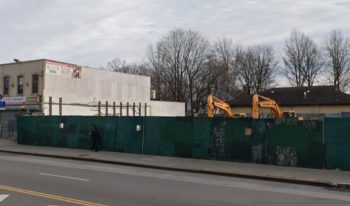
211-12 Northern Boulevard, Queens. Image Credit: Google Maps.
Contractor damaged neighboring building while excavating vacant lot in preparation for building parking garage. LIC Contracting, Inc. was hired by a company that owned a vacant lot located at 211-02 and 211-04 Northern Boulevard in Queens to construct a three-story commercial building with two-level underground parking on the premises. The project required that the lot be excavated to construct the parking structure.
Northern Boulevard Corp. owns a two-story commercial building next to the vacant lot. On August 12, 2015, the contractor served notice on the owner of the neighboring building that the excavation would commence. The notice did not detail the extent and duration of the excavation but did provide the neighboring building with contact information to voice any concerns.
On November 18, 2015, construction began in the area closest to the neighboring building. The contractor soon discovered cracks on an exterior wall of the neighboring building. The contractor spoke with the neighboring building owner, who allowed the contractor to finish pouring the concrete foundation. In turn, the contractor agreed to fix the cracks and shore up the building.
On the next day, November 19, 2015, the New York City Department of Buildings ordered the neighboring building to be vacated because the excavation had compromised the building’s structural stability. Buildings ordered the contractor to stop work, finding that the contractor had failed to protect the neighboring building’s structure. The commercial tenants who were forced to vacate subsequently stopped paying rent.
The owner of the neighboring building and one of the building’s tenants sued the contractor and related parties for damages caused by the excavation. Supreme Court Justice Carmen R. Velasquez agreed with the owners and tenant and granted summary judgement on liability in their favor. The contractor appealed.
The contractor argued on appeal that the owner of the neighboring building failed to demonstrate compliance with the Buildings Code which required the neighbor to grant a temporary license for the contractor to enter and protect the building, or alternatively, that the neighbor took their own actions to protect the building.
The Appellate Division, Second Department rejected the contractor’s argument and affirmed the Supreme Court’s decision holding the contractor liable.
The Appellate Division ruled that the contractor’s obligation under the Buildings Code to protect the neighboring property did not transfer to the neighbor because the contractors did not request the license from the neighbor prior to the excavation work commencing. It was only after the damage was done that the parties met to discuss granting the contractor access to the neighboring building.
211-12 Northern Blvd. Corp. v. LIC Contr., Inc., 128 N.Y.S.3d 551 (2d Dep’t 2020).
By: Nicholas Negron (Nicholas is a New York Law School student, Class of 2022.)

